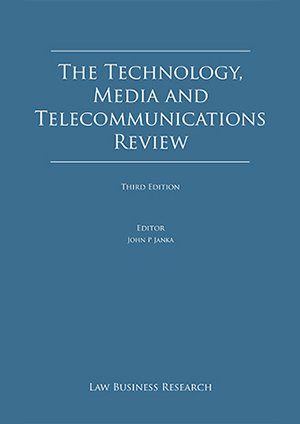This fully updated sixth edition of The Technology, Media and Telecommunications Review provides an overview of the evolving legal constructs relevant to both existing service providers and start-ups in 29 jurisdictions around the world. It is intended as a businessfocused framework for beginning to examine evolving law and policy in the rapidly changing TMT sector.
The burgeoning demand for broadband service, and for radio spectrum-based communications in particular, continues to drive law and policy in the TMT sector. The disruptive effect of these new ways of communicating creates similar challenges around the world:
- (a) the need to facilitate the deployment of state-of-the-art communications
infrastructure to all citizens;
- (b) the reality that access to the global capital market is essential to finance that
infrastructure;
- (c) the need to use the limited radio spectrum more efficiently than before;
- (d) the delicate balance between allowing network operators to obtain a fair return on their assets and ensuring that those networks do not become bottlenecks that stifle innovation or consumer choice; and
- (e) the growing influence of the ‘new media’ conglomerates that result from increasing consolidation and convergence.
A global focus exists on making radio spectrum available for a host of new demands, such as the developing ‘Internet of Things,’ broadband service to aeroplanes and vessels, and the as yet undefined, next-generation wireless technology referred to as ‘5G’. This process involves ‘refarming’ existing bands, so that new services and technologies can access spectrum previously set aside for businesses that either never developed or no longer have the same spectrum needs. In many cases, an important first step will occur at the World Radiocommunication Conference in November 2015, in Geneva, Switzerland, where countries from around the world will participate in a process that sets the stage for these new applications. No doubt, this conference will lead to changes in long-standing radio spectrum allocations that have not kept up with advances in technology, and it should also address the flexible ways that new technologies allow many different services to co- exist in the same segment of spectrum.
Many telecommunications networks once designed primarily for voice are now antiquated and not suitable for the interactive broadband applications that can extend economic benefits, educational opportunities and medical services throughout a nation. As a result, many governments are investing in or subsidising broadband networks to ensure that their citizens can participate in the global economy, and have universal access to the vital information, entertainment and educational services now delivered over broadband. Governments are also re-evaluating how to regulate broadband providers, whose networks have become essential to almost every citizen. Convergence, vertical integration and consolidation are also leading to increased focus on competition and, in some cases, to changes in the government bodies responsible for monitoring and managing competition in the TMT sector.
Changes in the TMT ecosystem, including the increased reliance by content providers on broadband for video distribution, have also led to a policy focus on ‘network neutrality’ – the goal of providing some type of stability for the provision of important communications services on which almost everyone relies, while also addressing the opportunities for mischief that can arise when market forces work unchecked. While the stated goals of that policy focus are laudable, the way in which resulting law and regulation are implemented can have profound effects on the balance of power in the sector, and raises important questions about who should bear the burden of expanding broadband networks to accommodate the capacity strains created by content providers.
These continuing developments around the world are described in the following chapters, as well as the developing liberalisation of foreign ownership restrictions, efforts to ensure consumer privacy and data protection, and measures to ensure national security and facilitate law enforcement. Many tensions exist among the policy goals that underlie the resulting changes in the law. Moreover, cultural and political considerations often drive different responses at the national and the regional level, even though the global TMT marketplace creates a common set of issues.


